Nokia Lumia 900 Review - Windows Phone with LTE
by Brian Klug on April 3, 2012 9:00 PM ESTCellular, WiFi, GPS, Speakerphone
The Lumia 900 uses Qualcomm’s MDM9200 baseband for cellular connectivity. It’s a 45nm LTE UE category 3 part we’ve seen numerous times before (the MDM9600 is functionally the same but includes CDMA2000 1x and EVDO 3GPP2 suite air interface support) but this is the first time we’ve seen it (and LTE) on a Windows Phone. I have to admit that at first I wondered what use cases on Windows Phone could really benefit from the inclusion of LTE, but having faster cellular connectivity does indeed make a perceptible difference. Interestingly enough Nokia does note the presence of Rx diversity for WCDMA on the Lumia 900 front and center, both under their “design” tab and under Data Network on the specifications page. It’s awesome to see another handset vendor realize that great cellular performance is noteworthy, even if Nokia has always been shipping handsets with either pentaband or great performance.
| Nokia Lumia 900 AT&T- Network Support | |||||
| GSM/EDGE Support | 850 / 900 / 1800 / 1900 MHz | ||||
| WCDMA Support | 850 / 900 / 1900 MHz (official, 2100 / AWS in FCC) | ||||
| LTE support | 700 MHz (Band 17), AWS (Band 4) - UE Category 3 | ||||
| Baseband Hardware | QCT MDM9200 | ||||
| HSPA Speeds | HSDPA 21.1 (Cat 14) / HSUPA 5.76 (Cat.6) | ||||
Since the Lumia 900 is headed to AT&T LTE, it includes LTE band 17 (700 MHz) and band 4 (AWS) support. For 3G WCDMA the Lumia 900 supports the usual suspects outlined in the table below, but also includes AWS approval in the FCC database. Were you to score an unlocked Lumia 900 there’s a chance it might just work on T-Mobile. Just like the Lumia 800 I suspect there are a few variants of the Lumia 900 with different WCDMA bands supported.
To test cellular performance I used BandWidth from the Marketplace which appears to use the speedtest.net servers. I tested AT&T LTE up in the Phoenix, AZ market which is currently 10 MHz FDD-LTE on band 17 for AT&T which corresponds to a maximum of 73 Mbps of downstream for a UE Category 3 device. BandWidth only offers a limited history buffer and no export functionality, but I saw speeds of up to 35 Mbps on the Lumia 900 and average speeds around 15–20 Mbps. Subjectively what I’ve seen on the Lumia 900 is very similar to the performance I’ve seen testing an AT&T Galaxy Note in the same market whose data I’ll share soon.
On 3G WCDMA, performance is definitely helped out by the presence of Rx diversity. I have seen 10–11 Mbps at my house with excellent proximity to an AT&T cell site. In other traditionally challenging places the Lumia 900 does a great job staying connected in my home market which lacks AT&T LTE.
The Lumia 900’s cellular settings page includes the ability to switch the device’s preferred air interface between EDGE/GPRS (E), 3G WCDMA (3G), and 4G LTE (4G). However the labeling here is actually hilarious - AT&T’s WCDMA “4G” marketing carries over to the Lumia 900, so selecting “3G” from the drop down will score you a “4G” indicator in the status bar. Likewise selecting “4G” from the drop down gets you “LTE” in the status bar. Finally, a concrete example of where AT&T’s re-branding marketing has resulted in an actual namespace collision!
I think it’s also worth noting that the Lumia 900 includes an excellent field test app with fields for every air interface which you can launch by dialing ##3282# just like on many other WP7 devices.

Antenna positions (from FCC Test Report)
Like many other phones, the transmit antenna is at the bottom of the device for GSM, WCDMA, and LTE. The WCDMA Rx diversity antenna and LTE MIMO antenna is located on the side with the volume and power/standby buttons. Remember that every LTE category 2 and above device needs two receive antennas for MIMO.
A number of users have asked me whether or not the Lumia 900 works with any old AT&T SIM, or if you absolutely need the SIM that comes with the device and LTE provisioning. I swapped my normal iPhone data plan provisioned SIM into the Lumia 900 and was able to get 3G WCDMA working fine. I didn't get a chance to test whether AT&T LTE works with that SIM, but I strongly suspect it doesn't. One small extra step is that you will need to use Nokia’s Network Setup application (available on the Marketplace) to change your settings from AT&T LTE to AT&T 3G APNs as shown above (ostensibly from pta to phone) so you can get data working, otherwise it won’t work.
WiFi
The Lumia 900 includes 802.11b/g/n WiFi - there’s only 2.4 GHz support just like every other WP7 phone, no 5 GHz yet to speak of. The device also connects at a single spatial stream 802.11n 72 Mbps short guard interval, 20 MHz channel rate. I’m fairly confident that the Lumia 900 is using Broadcom’s BCM4329 just like the Lumia 800, but I’m unable to verify to be completely sure. Either way I haven’t seen anything errant with WiFi on the Lumia 900 at all, range and performance is totally acceptable.
The Lumia 900 locates the WiFi, Bluetooth and GPS antenna in the same place, part of a module which appears to be part of the headset jack based on the FCC description.
GPS
Speaking of GPS, I had no issues at all with getting a good GPS fix on the Lumia 900 either while just playing with Bing maps, Nokia Maps, or while getting turn by turn directions from Nokia Drive. I strongly suspect that the Lumia 900 is using the GNSS functionality off of MDM9200, but it’s not clear whether GLONASS is supported or this is just GPS.
Speakerphone
The Lumia 900 speaker is at the very bottom of the device, just like the 800. Subjectively I have no issues with the 900's volume at all, either while on a speakerphone call or using it for navigation using Nokia Drive. In our controlled test with a sound data logger placed 3 inches away from the phone, the result the Lumia 900 is above average and definitely louder than the Lumia 800.
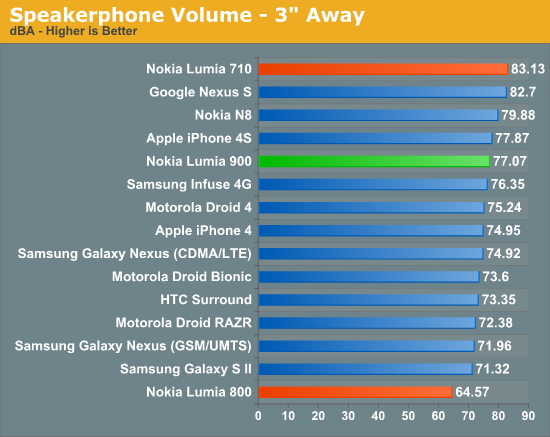
The next test is how well the Lumia 900's noise rejection works, which uses the second microphone at the very top in conjunction with the primary microphone in the speakerphone grille at bottom to do some common mode noise rejection. To test this I did what I always do and placed a call between the Lumia 900 and another AT&T phone (AMR-NB) and recorded the output of that call while increasing the volume of some music and decreasing it.
The results are excellent, as even at maximum volume I have a hard time discerning the background sound at all. I suspect that Nokia is using the Fluence noise rejection provided onboard the Qualcomm SoC, but I'm still not completely certain.


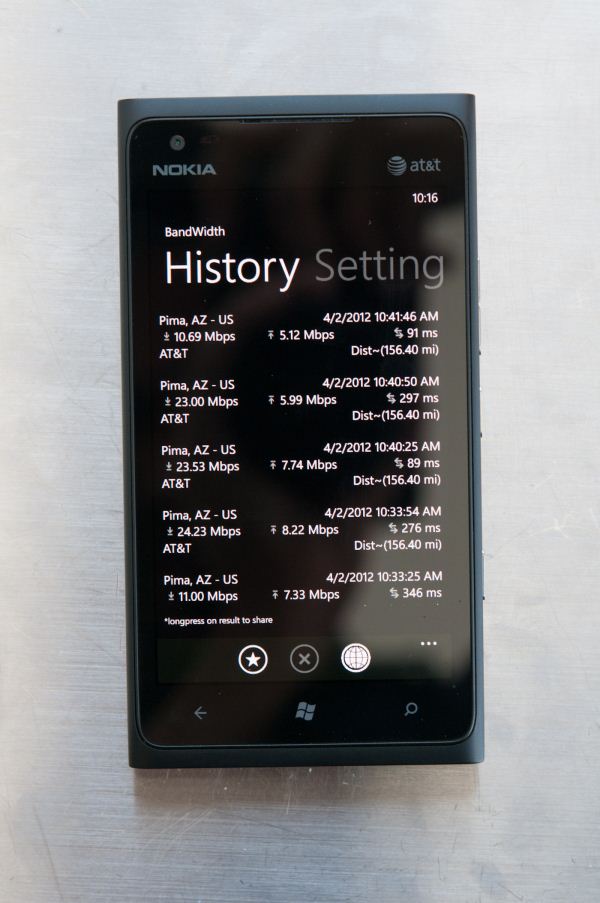
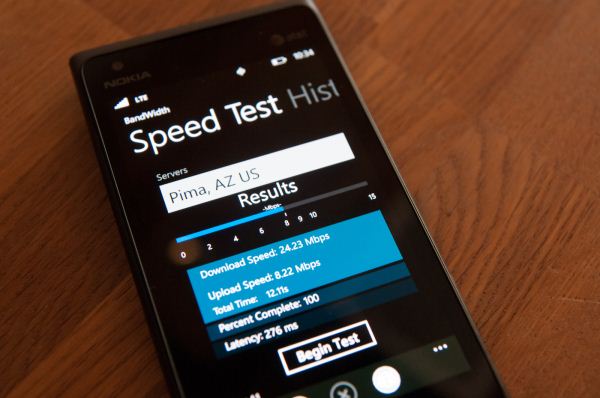
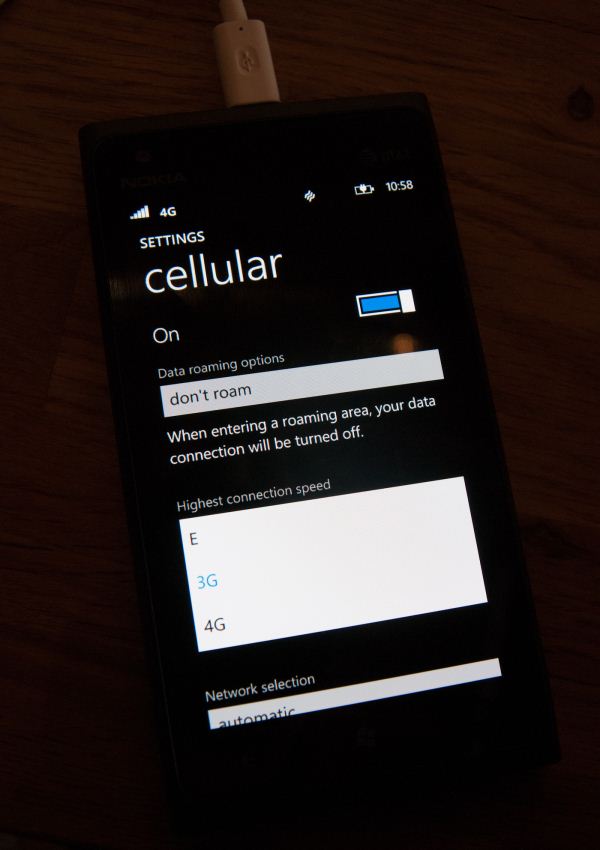
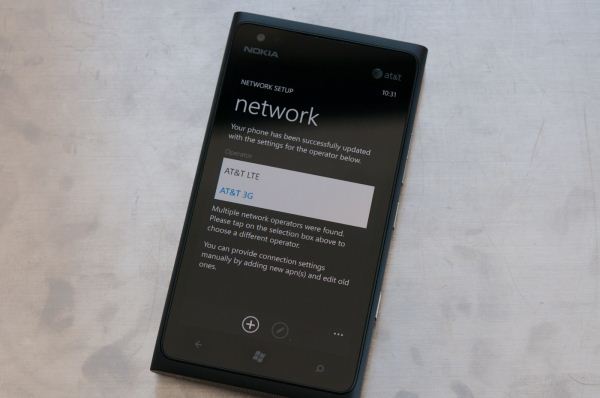








128 Comments
View All Comments
lunarx3dfx - Wednesday, April 4, 2012 - link
I agree with edd. I recently bought a focus flash after using a Nexus S for almost a year, and even with ics the Nexus wasn't anywhere near as smooth as WP7 is. Sure, gpu acceleration helped, but there are other underlying problems in Android.That being said however, I will probably be getting the HTC ONE X or the US GSM Galaxy Nexus (if it ever launches) because the one area WP really lacks is in providing features for power users. It is a beautiful os, and as a whole I really enjoy it, but I miss being able to customize everything like I could on android.
papatom - Wednesday, April 4, 2012 - link
Besides there is a lot more that the underlying OS has to offer.Let's see how WP subjective performance changes (tanks?) when Microsoft adds all those features.
They will bring the platform in-line feature wise, won't they?
Another thing, as pointed by Exodite, is that the first crop of WP phones - at least reference ones - comes from Nokia, and is polished to the point OS permits.
sprockkets - Wednesday, April 4, 2012 - link
I'm at 1.2ghz and 768 memory with only around 400 available for me to use! Sure it's dual core, but again, the GPU does its job now.Here, read this from an actual developer of Android.
https://plus.google.com/105051985738280261832/post...
mutatio - Wednesday, April 4, 2012 - link
Careful, Vision, that comes awful close to complimenting Apple's approach since day one of the iPhone. ;-)Exodite - Wednesday, April 4, 2012 - link
Ah yes, the wonders of anecdotal evidence and conjecture.Incidentially I have an Android phone based on very similar hardware, an 1GHz Qualcomm S2 SoC, 512MB memory and a FWVGA display.
And it runs absolutely beautifully.
It's the SE arc though, kinda funny how the old guard in phones still seem to come up with some of the best solutions.
designerfx - Friday, April 6, 2012 - link
wow, really?do you understand the point of quad core? it's not performance, it's more power savings.
WP is not more efficient than anyone - if you think it is the OS, you don't understand that probably 99% of the performance (positive or negative) is based on the chips in the phone and that's it.
crispbp04 - Tuesday, April 10, 2012 - link
You are clueless so please don't speak on subjects you have no idea about. Do you even know what a scheduling is? Maybe when you get an education some day after you graduate high school you'll understand how an operating system works.http://en.wikipedia.org/wiki/Scheduling_(computing...
Saying performance is all hardware is like saying strengh is everything. try holding a 25lb weight 2 feet from you with your arms extended, then hold the same weight to your chest. What is easier?
eddman - Tuesday, April 3, 2012 - link
Why talk time and 3G web browsing battery times are so low, compared to phones with a similar display and a similar or smaller battery?Is this one of the pitfalls of using a dedicated baseband chip?
Brian Klug - Wednesday, April 4, 2012 - link
Basically that, and again that we're talking about (at least for the cellular page loading tests) the same display being the majority of power draw.The tethering results being so close surprised me, and I'm going to re-run the HSPA+ result just to see what was up there. Again very limited time on this review actually.
-Brian
Lonegunman2012 - Wednesday, April 4, 2012 - link
Just a quick question: What is your rush to get the review out? I look to this site for thoroughly written reviews. It's disappointing that so much was left out. I would be happy to wait longer for a review to come out if it was complete.